Comparison of Hafnium Dioxide and Zirconium Dioxide Grown by Plasma-Enhanced Atomic Layer Deposition for the Application of Electronic Materials
Abstract
1. Introduction
2. Experimental Details
3. Results and Discussion
4. Summary
Author Contributions
Funding
Acknowledgments
Conflicts of Interest
References
- Wong, H.-S.P. Beyond the conventional transistor. IBM J. Res. Dev. 2002, 46, 133–168. [Google Scholar] [CrossRef]
- Robertson, J. High dielectric constant gate oxides for metal oxide Si transistors. Rep. Prog. Phys. 2006, 69, 327–396. [Google Scholar] [CrossRef]
- Robertson, J.; Wallace, R.M. High-K materials and metal gates for CMOS applications. Mater. Sci. Eng. 2005, R88, 1–41. [Google Scholar] [CrossRef]
- Al-Kuhaili, M.F.; Durrani, S.M.A.; Khawaja, E.E. Characterization of hafnium oxide thin films prepared by electron beam evaporation. J. Phys. D Appl. Phys. 2004, 37, 1254–1261. [Google Scholar] [CrossRef]
- Smith, R.C.; Ma, T.; Hoilien, N.; Tsung, L.Y.; Bevan, M.J.; Colombo, L.; Roberts, J.; Campbell, S.A.; Gladfelter, W.L. Chemical vapour deposition of the oxides of titanium, zirconium and hafnium for use as high-k materials in microelectronic devices. A carbon-free precursor for the synthesis of hafnium dioxide. Adv. Mater. Opt. Electron. 2000, 10, 105–114. [Google Scholar] [CrossRef]
- Lee, U.S.; Choi, J.S.; Yang, B.S.; Oh, S.; Kim, Y.J.; Oh, M.S.; Heo, J.; Kima, H.J. Formation of a bilayer of ALD-SiO2 and sputtered Al2O3/ZrO2 films on polyethylene terephthalate substrates as a moisture barrier. ECS Solid State Lett. 2013, 2, R13–R15. [Google Scholar]
- Venkataraj, S.; Kappertz, O.; Weis, H.; Drese, R.; Jayavel, R.; Wuttig, M. Structural and optical properties of thin zirconium oxide films prepared by reactive direct current magnetron sputtering. J. Appl. Phys. 2002, 92, 3599–3607. [Google Scholar] [CrossRef]
- Chang, J.P.; Lin, Y.S.; Chu, K. Rapid thermal chemical vapor deposition of zirconium oxide for metal-oxide semiconductor field effect transistor application. J. Vac. Sci. Technol. B 2001, 19, 1782–1787. [Google Scholar] [CrossRef]
- Nienow, A.M.; Roberts, J.T. Chemical vapor deposition of zirconium oxide on aerosolized silicon nanoparticles. Chem. Mater. 2006, 18, 5571–5577. [Google Scholar] [CrossRef]
- Choi, K.J.; Shin, W.C.; Yoon, S.G. Ultrathin HfO2 gate dielectric grown by plasma-enhanced chemical vapor deposition using Hf [OC (CH3)3]4 as a precursor in the absence of O2. J. Mater. Res. 2003, 18, 60–65. [Google Scholar] [CrossRef]
- Katoa, H.; Nango, T.; Miyagawa, T.; Katagiri, T.; Seol, K.S.; Ohki, Y. Plasma-enhanced chemical vapor deposition and characterization of high-permittivity hafnium and zirconium silicate films. J. Appl. Phys. 2002, 92, 1106–1111. [Google Scholar] [CrossRef]
- McNeill, D.W.; Bhattacharya, S.; Wadsworth, H.; Ruddell, F.H.; Mitchell, S.J.N.; Armstrong, B.M.; Gamble, H.S. Atomic layer deposition of hafnium oxide dielectrics on silicon and germanium substrates. J. Mater. Sci. Mater. Electron. 2008, 19, 119. [Google Scholar] [CrossRef]
- Senzaki, Y.; Park, S.; Chatham, H.; Bartholomew, L.; Nieveen, W. Physical and electrical characterization of Ce-HfO2 thin films deposited by thermal atomic layer deposition. J. Vac. Sci. Technol. A 2004, 22, 1175–1181. [Google Scholar] [CrossRef]
- Hausmann, D.M.; Kim, E.; Becker, J.; Gordon, R.G. Atomic layer deposition of hafnium and zirconium oxides using metal amide precursors. Chem. Mater. 2002, 14, 4350–4358. [Google Scholar] [CrossRef]
- Nomura, K.; Ohta, H.; Ueda, K.; Kamiya, T.; Hirano, M.; Hosono, H. Thin-film transistor fabricated in single-crystalline transparent oxide semiconductor. Science 2003, 300, 1269–1272. [Google Scholar] [CrossRef]
- Cheynet, M.C.; Pokrant, S.; Tichelaar, F.D.; Rouviere, J.L. Crystal structure and band gap determination of HfO2 thin films. J. Appl. Phys. 2007, 101, 054101–054108. [Google Scholar] [CrossRef]
- Bohra, F.; Jiang, B.; Zuo, J.M. Textured crystallization of ultrathin hafnium oxide films on silicon substrate. Appl. Phys. Lett. 2007, 90, 161917. [Google Scholar] [CrossRef]
- Kim, H.; Mclntyre, P.C.; Saraswat, K.C. Effects of crystallization on the electrical properties of ultrathin dielectrics grown by atomic layer deposition. Appl. Phys. Lett. 2003, 82, 106–108. [Google Scholar] [CrossRef]
- Lao, S.X.; Martin, R.M.; Chang, J.P. Plasma enhanced atomic layer deposition of HfO2 and ZrO2 high-k thin films. J. Vac. Sci. Technol. A 2005, 23, 488–496. [Google Scholar] [CrossRef]
- Jung, H.; Oh, I.K.; Yoon, C.M.; Park, B.E.; Lee, S.; Kwon, O.; Lee, W.J.; Kwon, S.H.; Kim, W.H.; Kim, H. Effects of Ar addition to O2 plasma on plasma-enhanced atomic layer deposition of oxide thin films. ACS Appl. Mater. Interfaces 2018, 10, 40286–40293. [Google Scholar] [CrossRef]
- Xiao, Z.; Mantei, T.D. Deposition of hard metal nitride-like coatings in an electron cyclotronresonance discharge. Surf. Coat. Technol. 2004, 177, 389–393. [Google Scholar] [CrossRef]
- Xiao, Z.; Mantei, T.D. Plasma-assisted growth of bilayer silicon-containing coatings for hardness and corrosion resistance. J. Vac. Sci. Technol. A 2004, 22, 1124–1128. [Google Scholar] [CrossRef]
- Xiao, Z. Robust and inexpensive thermal vaporizer for low-vapor pressure liquids. Rev. Sci. Instrum. 2003, 74, 3879–3880. [Google Scholar] [CrossRef]
- George, S.M. Atomic layer deposition: An overview. Chem. Rev. 2010, 110, 111–131. [Google Scholar] [CrossRef]
- McDaniel, M.D.; Ngo, T.Q.; Hu, S.; Posadas, A.; Demkov, A.A.; Ekerdt, J.G. Atomic layer deposition of perovskite oxides and their epitaxial integration with Si, Ge, and other semiconductors. Appl. Phys. Rev. 2015, 2, 041301. [Google Scholar] [CrossRef]
- Motamedi, P.; Cadienn, K. Structural and optical characterization of low-temperature ALD crystalline AlN. J. Cryst. Growth 2015, 421, 45–52. [Google Scholar] [CrossRef]
- Johnson, R.W.; Hultqvist, A.; Stacey, F.B. A brief review of atomic layer deposition: From fundamentals to applications. Mater. Today 2014, 17, 236–246. [Google Scholar] [CrossRef]
- Profijt, H.B.; Potts, S.E.; van de Sanden, M.C.M.; Kesselsa, W.M.M. Plasma-assisted atomic layer deposition: Basics, opportunities, and challenges. J. Vac. Sci. Technol. A 2011, 29, 050801. [Google Scholar] [CrossRef]
- Zhang, Y.; Ren, W.; Jiang, Z.; Yang, S.; Jing, W.; Shi, P.; Wu, X.; Ye, Z.G. Low-temperature remote plasma-enhanced atomic layer deposition of graphene and characterization of its atomic-level structure. J. Mater. Chem. C 2014, 2, 7570–7574. [Google Scholar] [CrossRef]
- Huang, R.G.; Tham, D.; Wang, D.; Heath, J.R. High performance ring oscillators from 10-nm wide silicon nanowire field-effect transistors. Nano Res. 2011, 4, 1005–1012. [Google Scholar] [CrossRef]
- Wang, H.; Yu, L.; Lee, Y.H.; Shi, Y.; Hsu, A.; Chin, M.L.; Li, L.J.; Dubey, M.; Kong, J.; Palacios, T. Integrated circuits based on bilayer MoS2 transistors. Nano Lett. 2012, 12, 4674–4680. [Google Scholar] [CrossRef] [PubMed]
- Xiao, Z.; Kisslinger, K. Electron-beam-evaporated thin films of hafnium dioxide for fabricating electronic devices. J. Vac. Sci. Technol. B 2015, 33, 042001. [Google Scholar] [CrossRef]
- Luo, X.; Li, Y.; Yang, H.; Liang, Y.; He, K.; Sun, W.; Lin, H.; Yao, S.; Lu, X.; Wan, L.; et al. Investigation of HfO2 thin films on Si by X-ray photoelectron spectroscopy, Rutherford backscattering, grazing incidence X-ray diffraction and variable angle spectroscopic ellipsometry. Crystals 2018, 8, 248. [Google Scholar] [CrossRef]
- Houska, J. Molecular dynamics study of the growth of crystalline ZrO2. Surf. Coat. Technol. 2016, 304, 23–30. [Google Scholar] [CrossRef]
- Ramzan, M.; Wasiq, M.F.; Rana, A.M.; Ali, S.; Nadeem, M.Y. Characterization of e-eam evaporated hafnium oxide thin films on post thermal annealing. Appl. Surf. Sci. 2013, 283, 617–622. [Google Scholar] [CrossRef]
- Zhao, Z.W.; Tay, B.K.; Huang, L.; Yu, G.Q. Study of the structure and optical properties of nanocrystalline zirconium oxide thin films deposited at low temperatures. J. Phys. D Appl. Phys. 2004, 37, 1701–1705. [Google Scholar] [CrossRef]
- Vicek, J.; Belosludtsev, A.; Rezek, J.; Houska, J.; Capek, J.; Cerstvy, R.; Haviar, S. High-rate reactive high-power impulse magnetron sputtering of hard and optically transparent HfO2 films. Surf. Coat. Technol. 2016, 290, 58–64. [Google Scholar]
- Vicek, J.; Rezek, J.; Houska, J.; Kozak, T.; Kohout, J. Benefits of the controlled reactive high-power impulse magnetron sputtering of stoichiometric ZrO2 films. Vacuum 2015, 114, 131–141. [Google Scholar]
- Ramzan, M.; Rana, A.M.; Ahmed, E.; Wasiq, M.F.; Bhatti, A.S.; Hafeez, M.; Ali, A.; Nadeem, M.Y. Optical characterization of hafnium oxide thin films for heat mirrors. Mater. Sci. Semi. Process. 2015, 32, 22–30. [Google Scholar] [CrossRef]
- Sidqi, N.; Clark, C.; Buller, G.S.; Krishna, G.; Thalluri, V.V.; Mitrofanov, J.; Noblet, Y. Comparative study of dielectric coating materials for micro-cavity applications. Opt. Mater. Expr. 2019, 9, 3452–3468. [Google Scholar] [CrossRef]
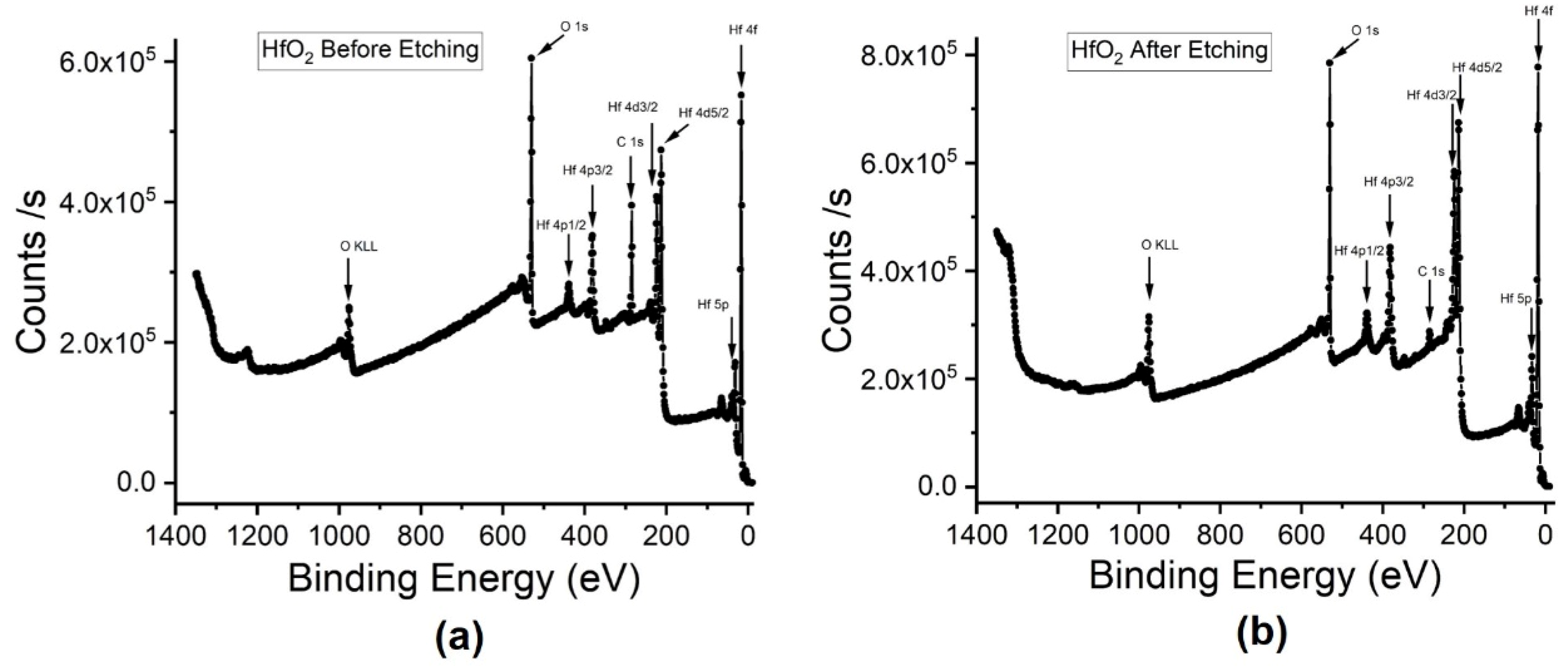
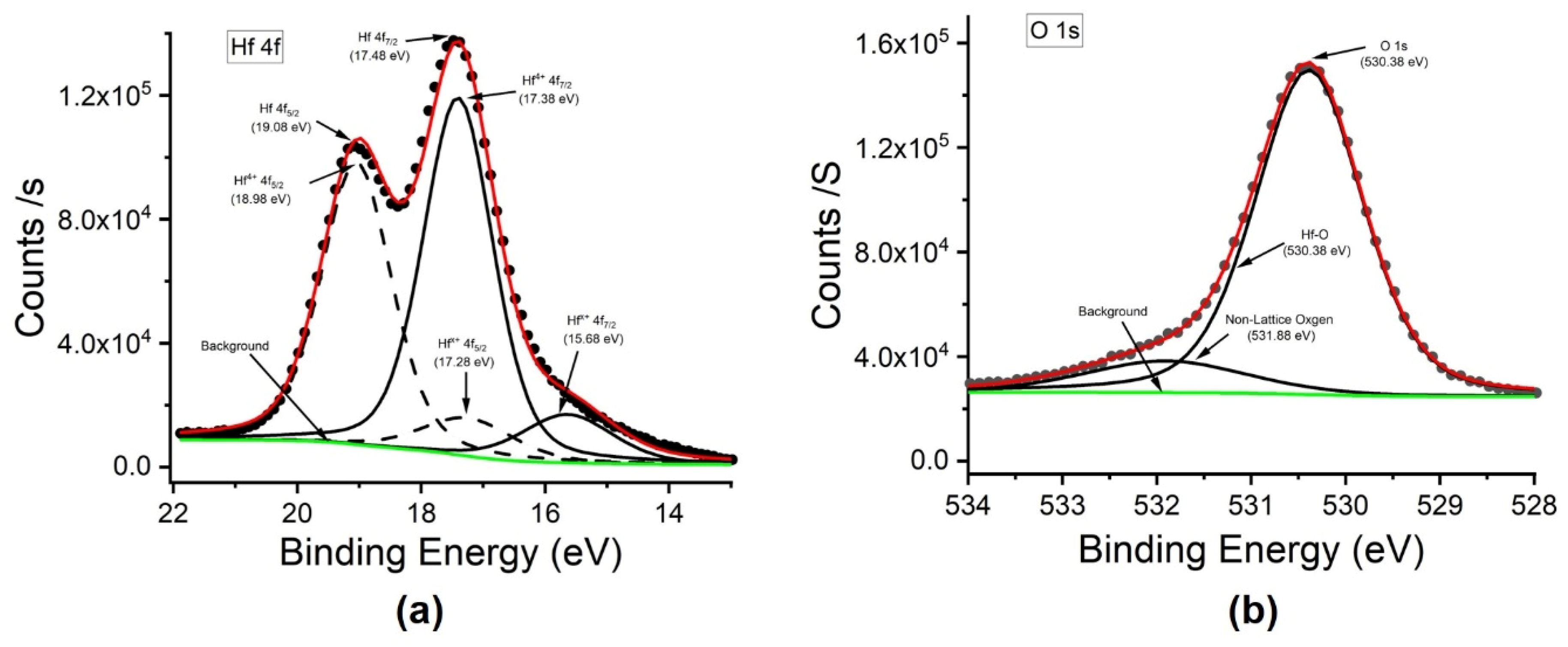

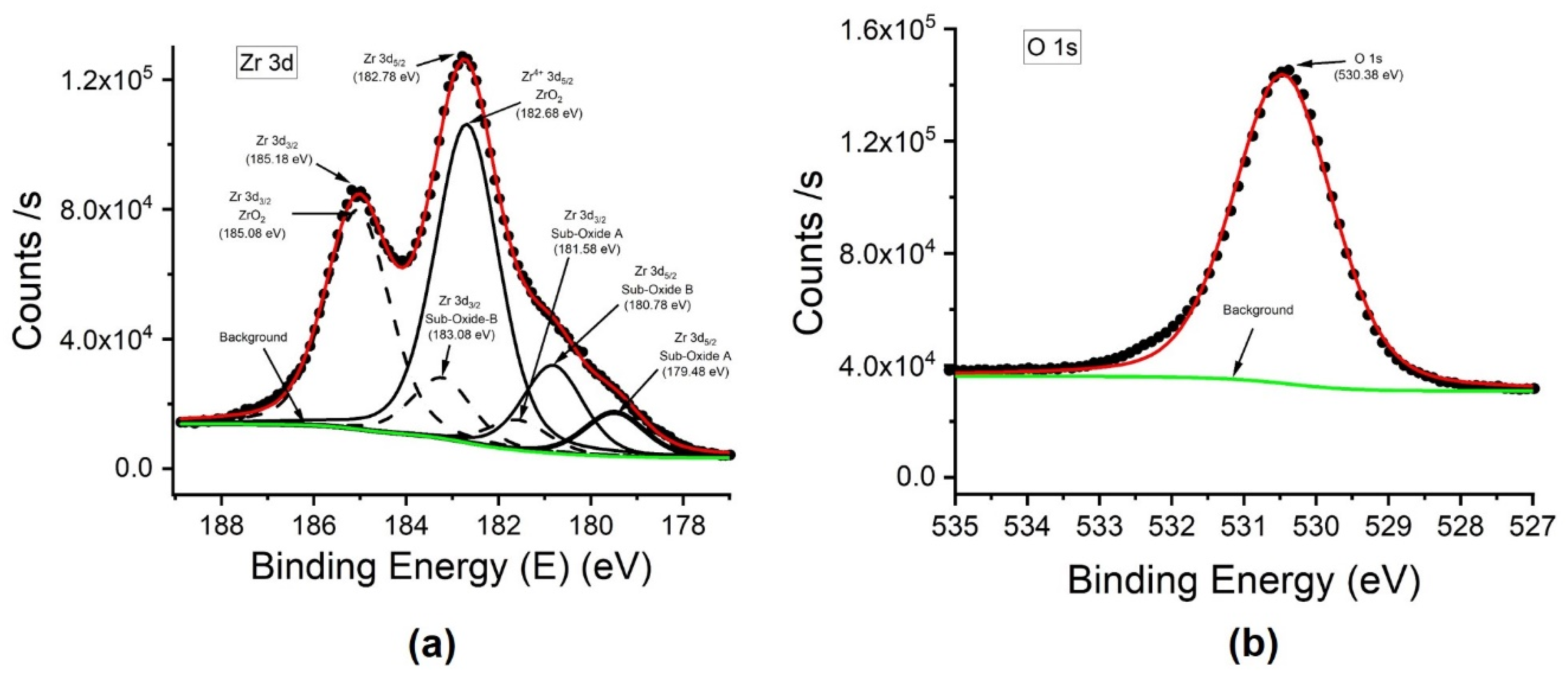
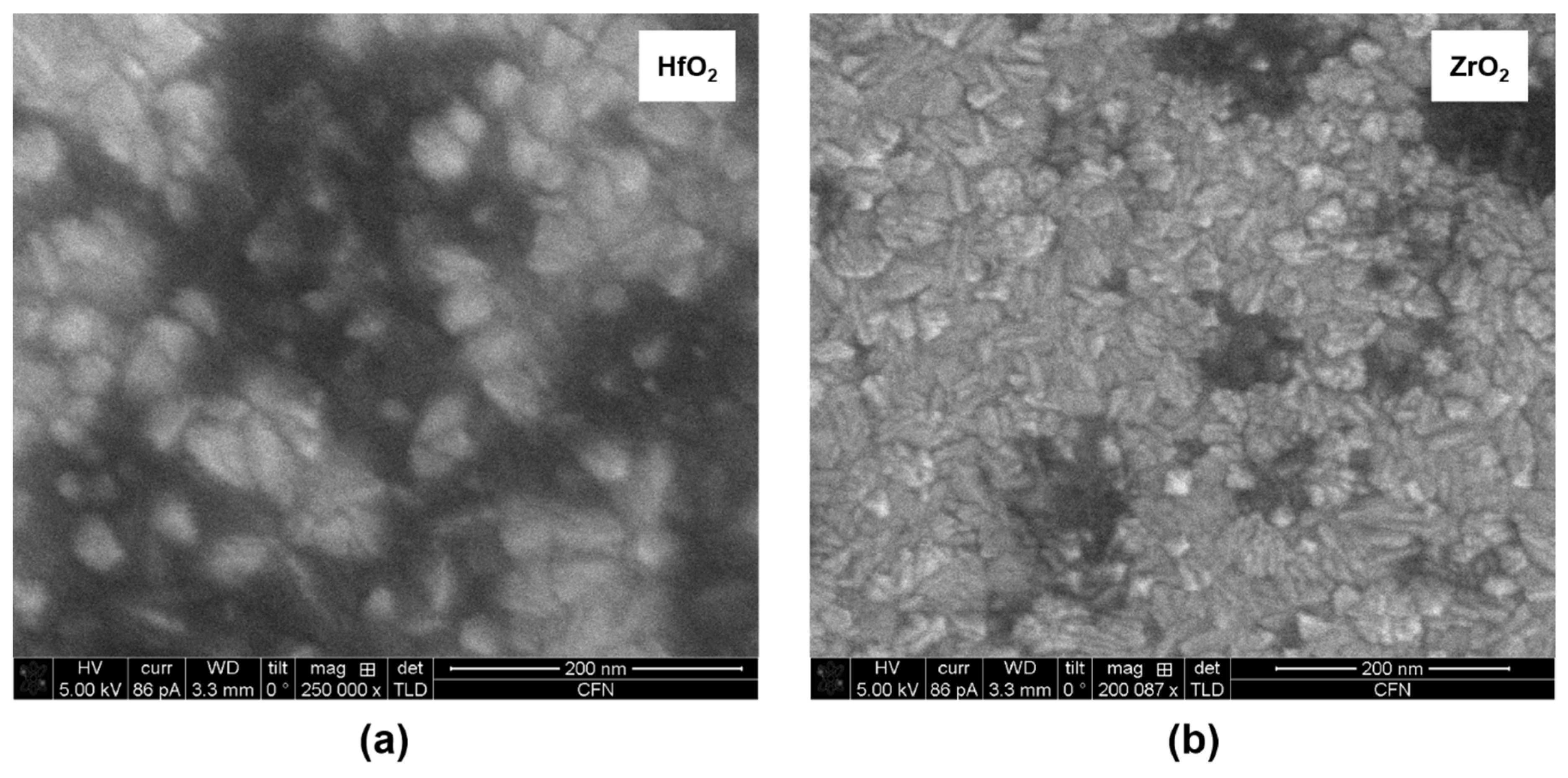
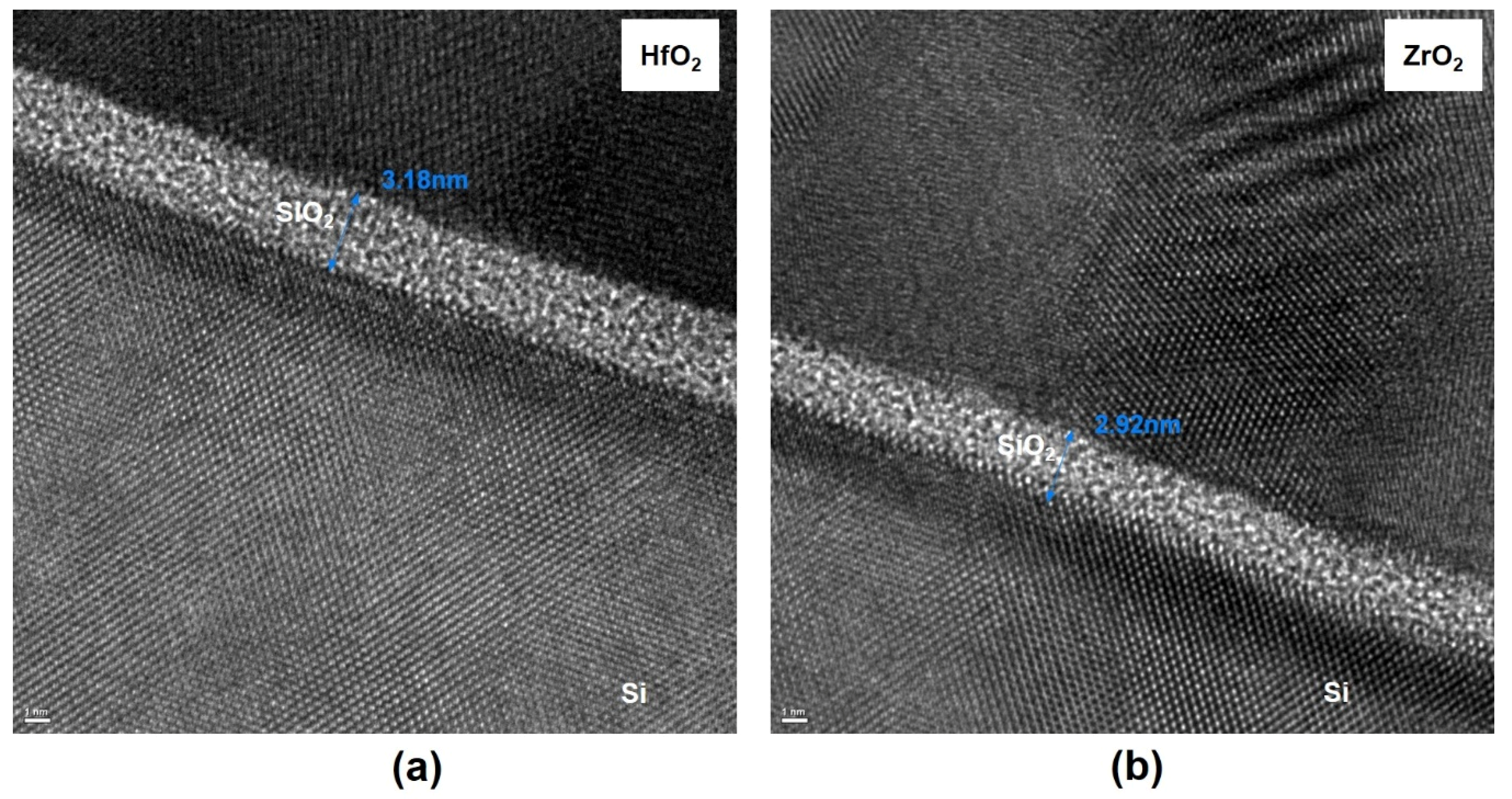
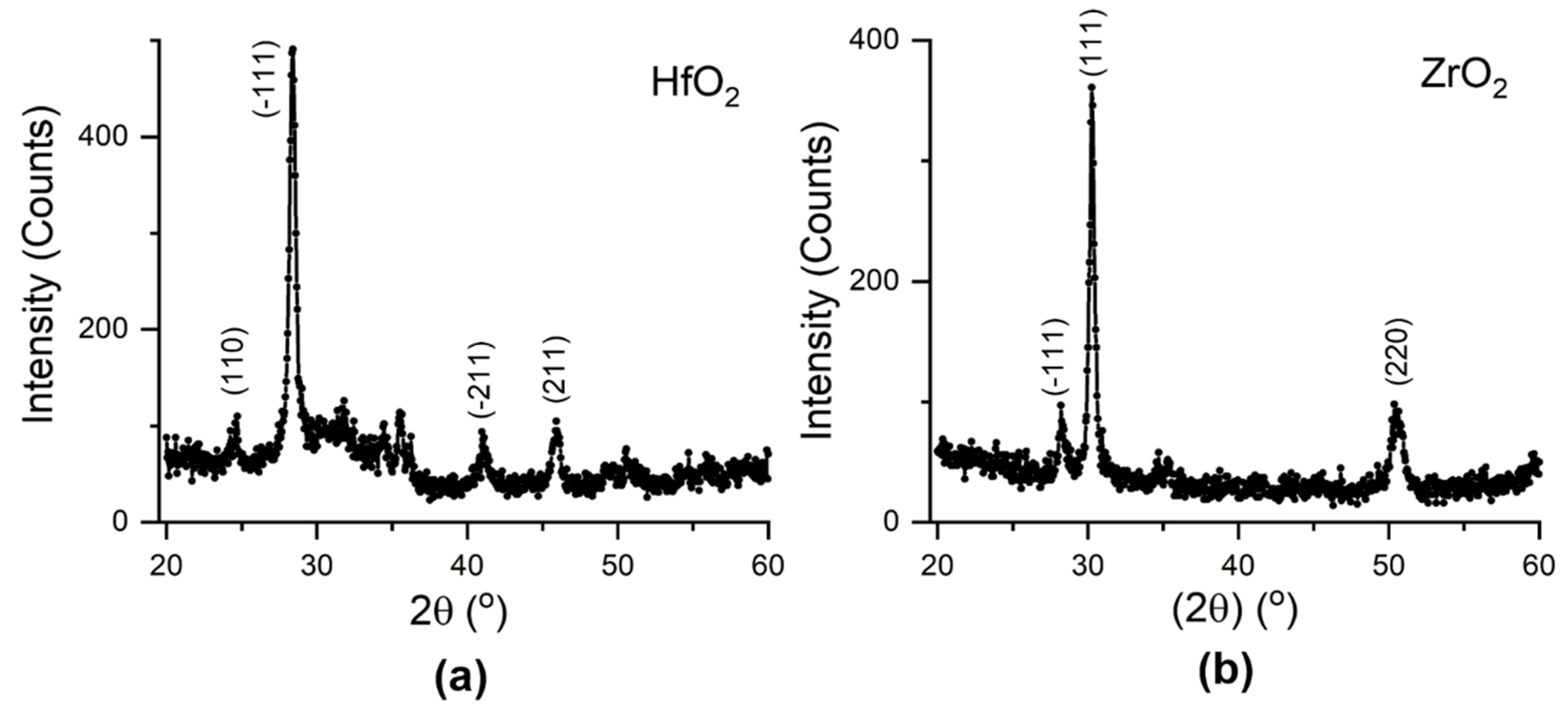
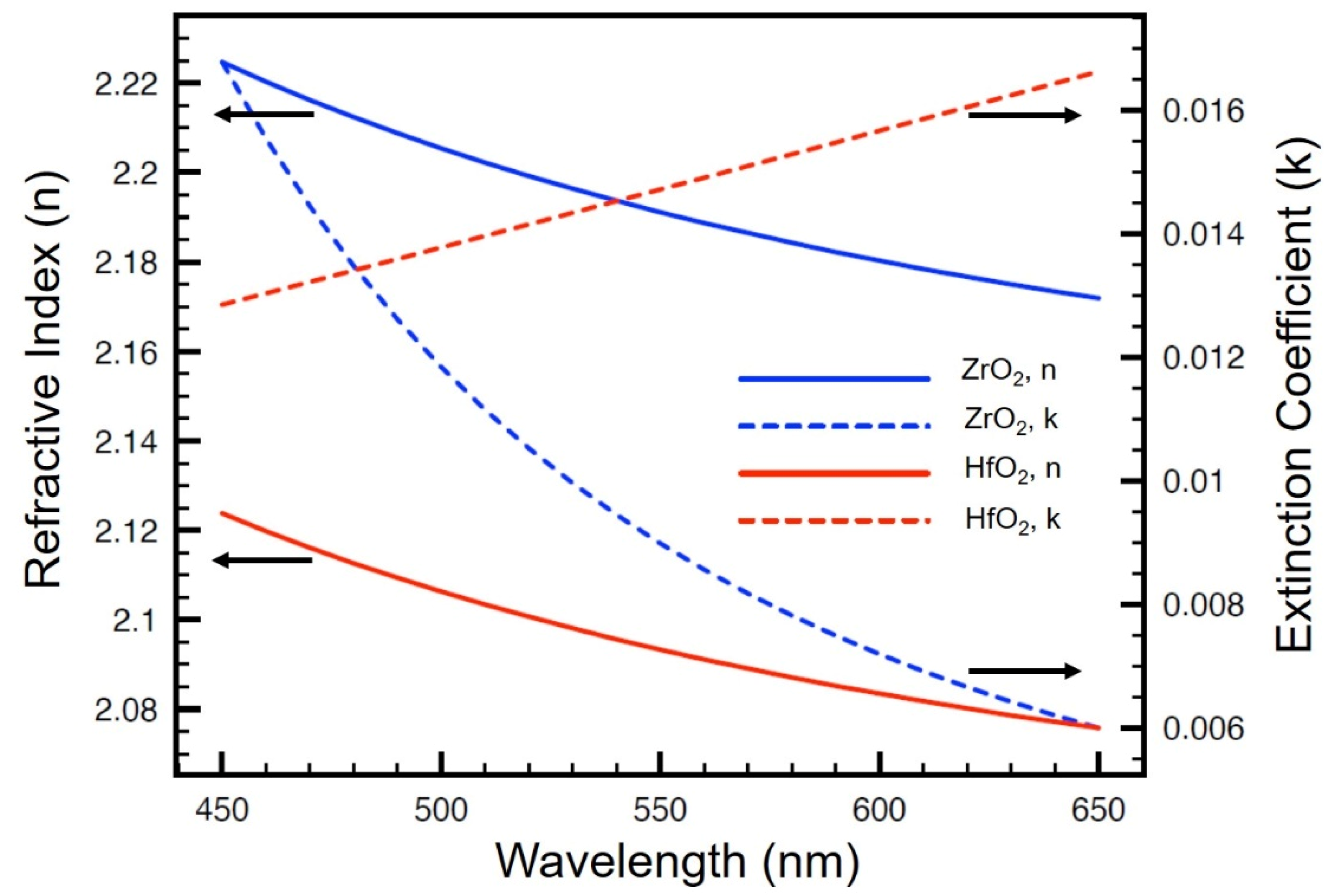
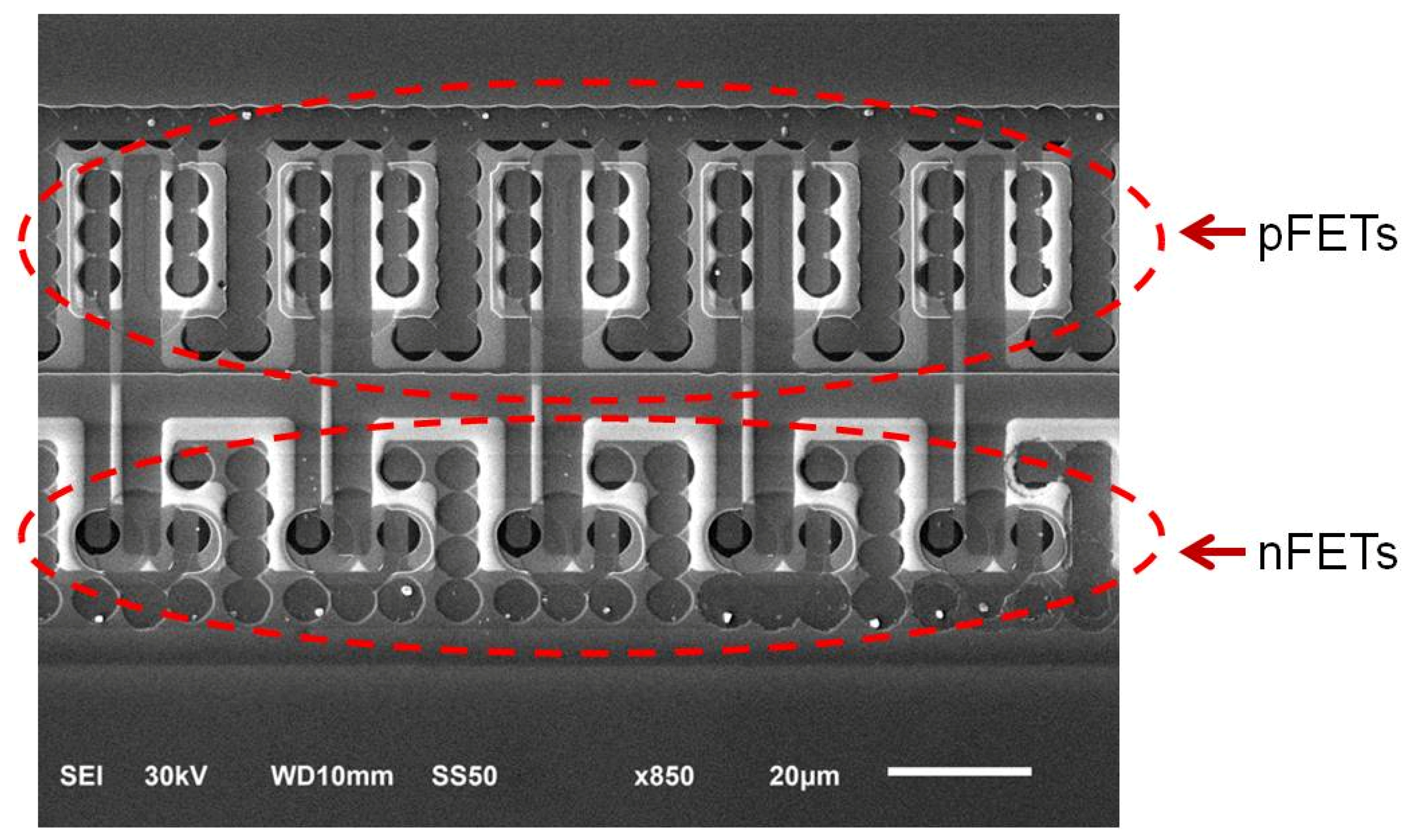
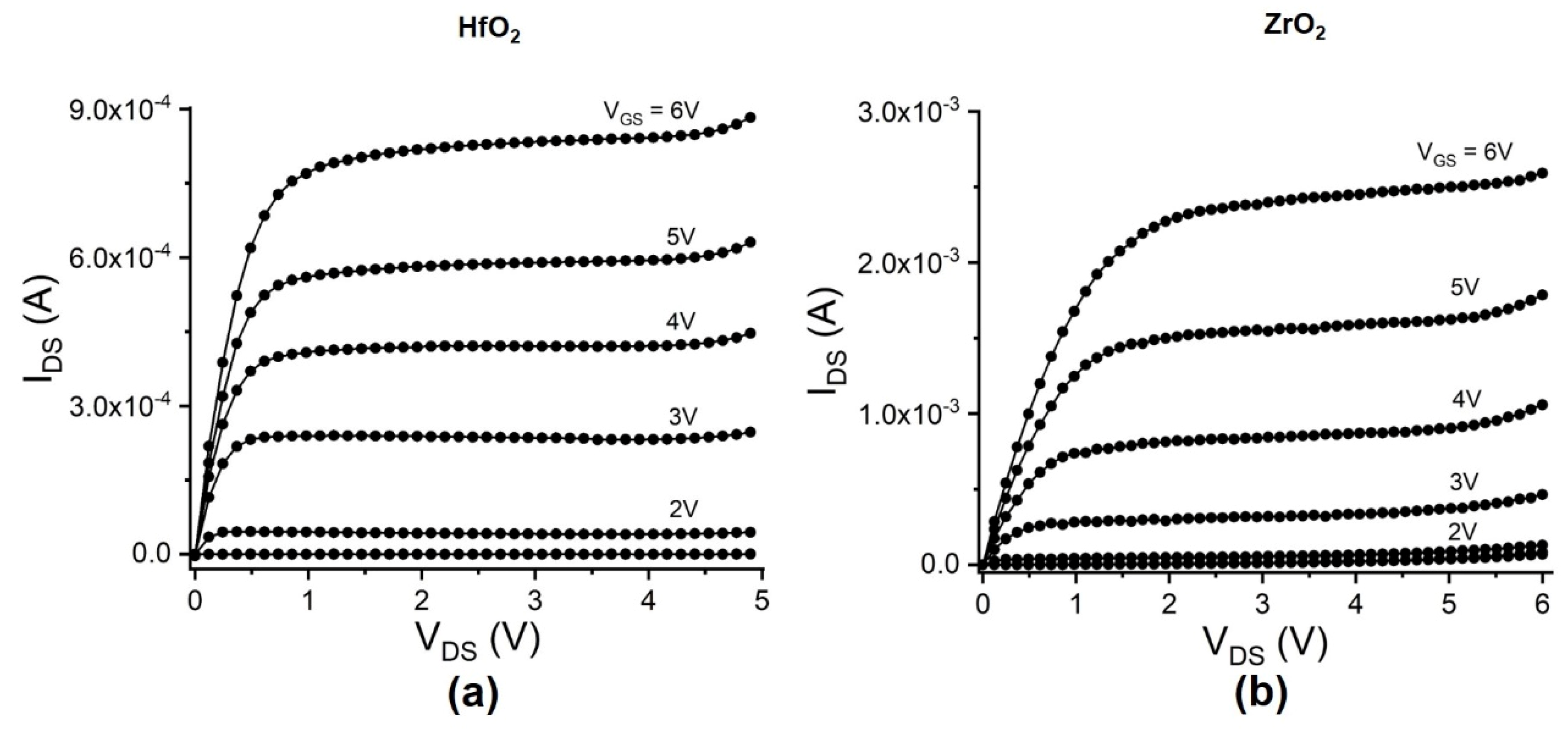
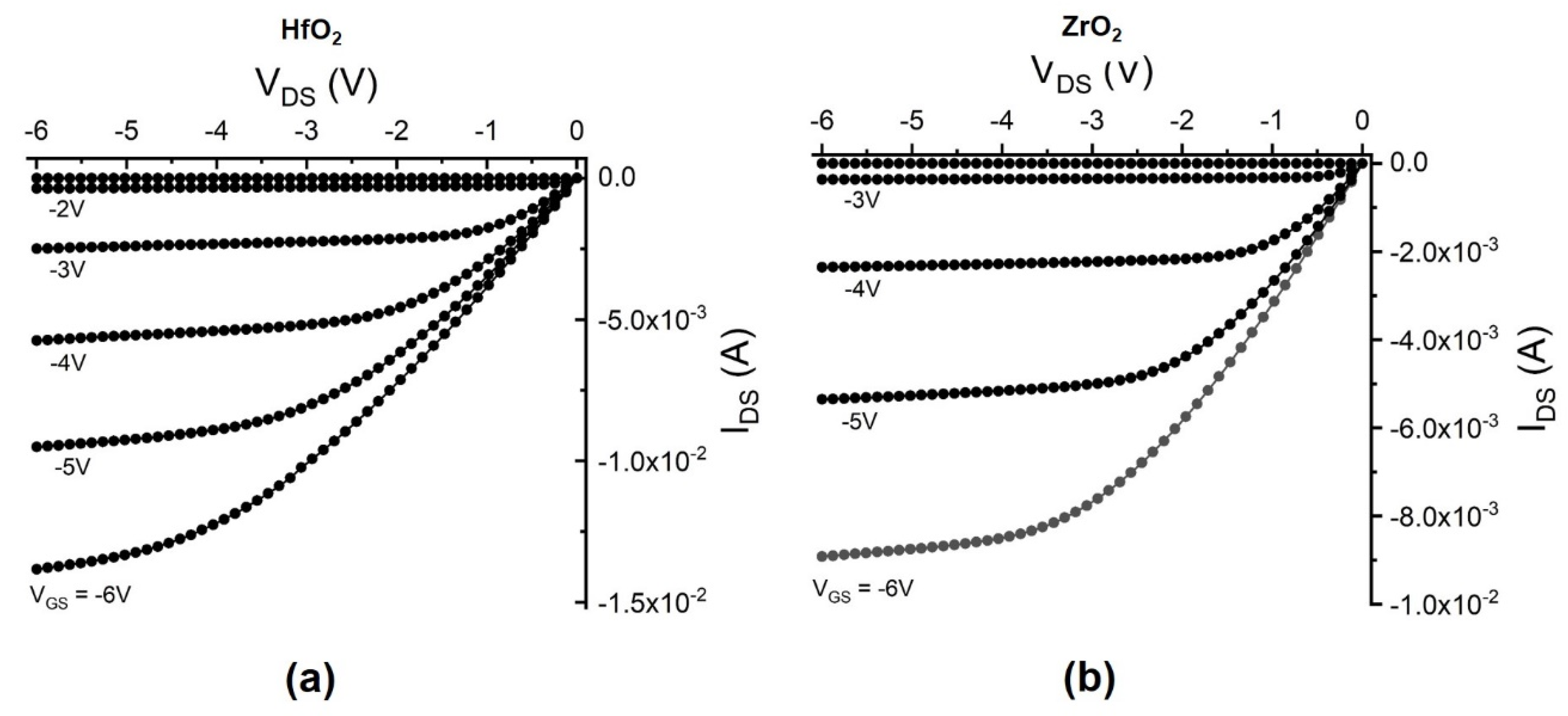
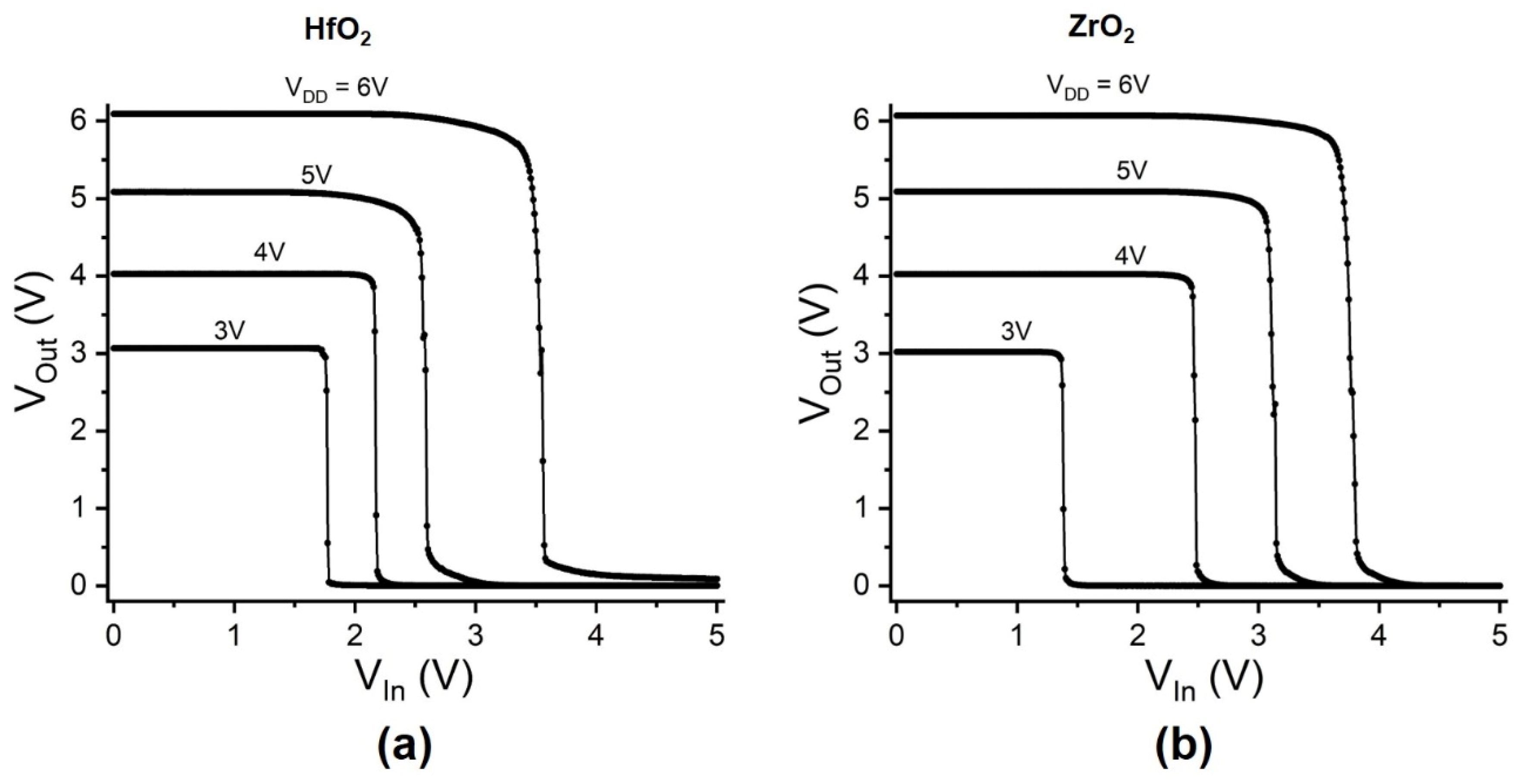
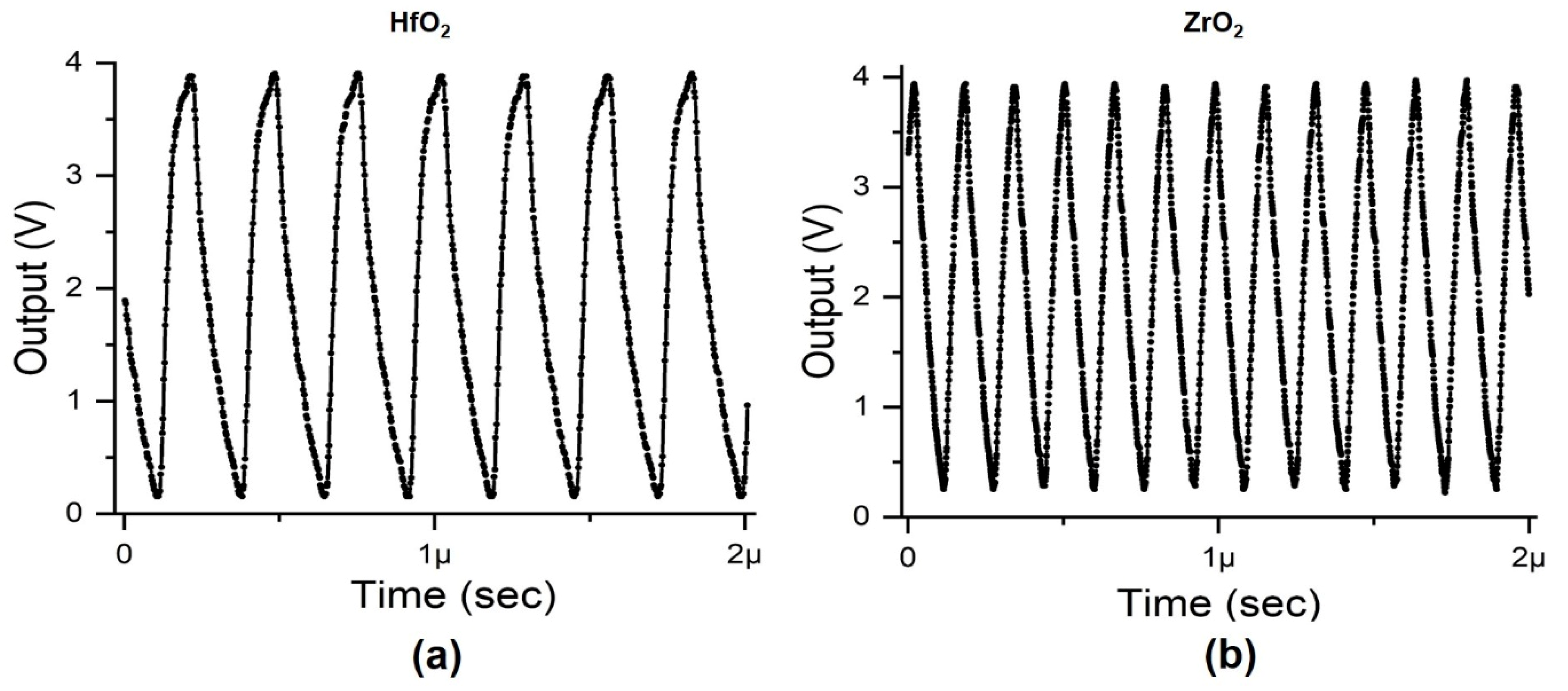
| Atomic Concentration (%) of HfO2 Film | Atomic Concentration (%) of ZrO2 Film | |||||
|---|---|---|---|---|---|---|
| Hf | C | O | Zr | C | O | |
| Before Etching | 17 | 41 | 42 | 22 | 27 | 51 |
| After Etching | 29 | 11 | 60 | 34 | 2 | 64 |
© 2020 by the authors. Licensee MDPI, Basel, Switzerland. This article is an open access article distributed under the terms and conditions of the Creative Commons Attribution (CC BY) license (http://creativecommons.org/licenses/by/4.0/).
Share and Cite
Xiao, Z.; Kisslinger, K.; Chance, S.; Banks, S. Comparison of Hafnium Dioxide and Zirconium Dioxide Grown by Plasma-Enhanced Atomic Layer Deposition for the Application of Electronic Materials. Crystals 2020, 10, 136. https://doi.org/10.3390/cryst10020136
Xiao Z, Kisslinger K, Chance S, Banks S. Comparison of Hafnium Dioxide and Zirconium Dioxide Grown by Plasma-Enhanced Atomic Layer Deposition for the Application of Electronic Materials. Crystals. 2020; 10(2):136. https://doi.org/10.3390/cryst10020136
Chicago/Turabian StyleXiao, Zhigang, Kim Kisslinger, Sam Chance, and Samuel Banks. 2020. "Comparison of Hafnium Dioxide and Zirconium Dioxide Grown by Plasma-Enhanced Atomic Layer Deposition for the Application of Electronic Materials" Crystals 10, no. 2: 136. https://doi.org/10.3390/cryst10020136
APA StyleXiao, Z., Kisslinger, K., Chance, S., & Banks, S. (2020). Comparison of Hafnium Dioxide and Zirconium Dioxide Grown by Plasma-Enhanced Atomic Layer Deposition for the Application of Electronic Materials. Crystals, 10(2), 136. https://doi.org/10.3390/cryst10020136




